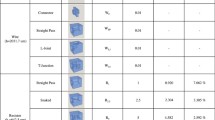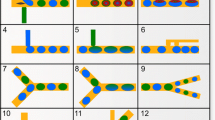Abstract
Recent years have seen the emergence of droplet-based microfluidic systems for safety-critical biomedical applications. In order to ensure reliability, microsystems incorporating microfluidic components must be tested adequately. In this paper, we investigate test planning and test resource optimization for droplet-based microfluidic arrays. We first formulate the test planning problem and prove that it is NP-hard. We then describe an optimization method based on integer linear programming (ILP) that yields optimal solutions. Due to the NP-hard nature of the problem, we develop heuristic approaches for optimization. Experimental results indicate that for large array sizes, the heuristic methods yield solutions that are close to provable lower bounds. These heuristics ensure scalability and low computation cost.
Similar content being viewed by others
References
T. Balch and R. Arkin, “Avoiding the Past: A Simple, But Effective Strategy for Reactive Navigation,” in Proc. Int. Conf. on Robotics and Automation, 1993, pp. 678–685.
M. Berkelaar, lpsolve. Eindhoven Univ. Technol., Eindhoven, The Netherlands. [Online]. Available: ftp://ftp.ics.ele.tue.nl/pub/lp_solve.
K.F. Böhringer, “Optimal strategies for moving droplets in digital microfluidic systems,” in Int. Conf. on Miniaturized Chemical and Biochemical Analysis Systems (MicroTAS’03), 2003, pp. 591–594.
N. Deb and R.D. Blanton, “Analysis of Failure Sources in Surface-Micromachined MEMS”, in Proc. IEEE Int. Test Conf., 2000, pp. 739–749.
J. Gross and J. Yellen, Graph Theory and its Applications, Boca Raton, FL: CRC Press, 1999.
C. Icking, T. Kamphans, R. Klein and E. Langetepe, “Exploring an Unknown Cellular Environment”, in Proc. European Workshop on Computational Geometry, 2000, pp. 140–143.
A. Itai, C.H. Papadimitriou and J.L. Szwarcfiter, “Hamilton Paths in Grid Graphs,” SIAM Journal on Computing, vol. 11, pp. 676–686, 1982.
H.G. Kerkhoff, “Testing Philosophy Behind the Micro Analysis System,” in Proc. SPIE: Design, Test and Microfabrication of MEMS and MOEMS, vol. 3680, 1999, pp. 78–83.
H.G. Kerkhoff and M. Acar, “Testable Design and Testing of Micro-Electro-Fluidic Arrays,” in Proc. IEEE VLSI Test Symposium, 2003, pp. 403–409.
H.G. Kerkhoff and H.P.A. Hendriks, “Fault Modeling and Fault Simulation in Mixed Micro-Fluidic Microelectronic Systems,” Journal of Electronic Testing: Theory and Applications (JETTA), vol. 17, pp. 427–437, 2001.
A. Kolpekwar and R.D. Blanton, “Development of a MEMS testing methodology,” in Proc. IEEE Int. Test Conf., 1997, pp. 923–931.
R.E. Korf, “Real-Time Heuristic Search,” Artificial Intelligence, vol. 42, pp.189–211, 1990.
W. Menz and A. Guber, “Microstructure Technologies and Their Potential in Medical Applications,” Minimally Invasive Neurosurgury, vol. 37, pp. 21–27, 1994.
S. Mir, B. Charlot and B. Courtois, “Extending Fault-Based Testing to Microelectromechanical Systems,” Journal of Electronic Testing: Theory and Applications (JETTA), vol. 16, pp. 279–288, 2000.
S. Mir, H. Kerkhoff, R.D. Blanton, H. Bederr, and H. Klim, “SoCs with MEMS? Can we include MEMS in the SoCs design and test flow?”, in Proc. IEEE VLSI Test Symposium, pp. 449, 2002.
S.D. Nigam and J.U. Turner, “Review of statistical approaches to tolerance analysis”, in Computer-Aided Design, vol. 27, pp. 6–25, 1995.
C.H. Papadimitriou, Computational Complexity, Reading, MA: Addison Wesley, 1993.
M. G. Pollack, R. B. Fair, and A. D. Shenderov, “Electrowetting-based actuation of liquid droplets for microfluidic applications”, Applied Physics Letters, vol. 77, pp. 1725–1726, 2000.
F. Su, W. Hwang, A. Mukherjee, and K. Chakrabarty, “Defect-Oriented Testing and Diagnosis of Digital Microfluidics-Based Biochip”, Proc. IEEE Int. Test Conf., 2005.
F. Su and K. Chakrabarty, “Design of Fault-Tolerant and Dynamically-Reconfigurable Microfluidic Biochips”, in Proc. Design, Automation and Test in Europe (DATE) Conference, pp. 1202–1207, 2005.
F. Su and K. Chakrabarty, “Architectural-level Synthesis of Digital Microfluidics-Based Biochips”, in Proc. IEEE International Conference on CAD, 2004, pp. 223–228.
F. Su, S. Ozev and K. Chakrabarty, “Testing of Droplet-Based Microelectrofluidic Systems”, in Proc. IEEE Int. Test Conf., 2003, pp. 1192–1200.
S. Thrun, Efficient Exploration in Reinforcement Learning. Technical Report CMU-CS-92-102, Carnegie Mellon University, 1992.
I. Wagner, M. Lindenbaum, and A. Bruckstein, “On-line Graph Searching by A Smell-Oriented Vertex Process”, in Proc. AAAI Workshop on On-Line Search, 1997, pp. 122–125.
H. P. Williams, Model Building in Mathematical Programming, John Wiley & Sons Ltd., 1999.
T. Zhang, K. Chakrabarty, and R. B. Fair, Microelectrofluidic Systems: Modeling and Simulation, Boca Raton, FL: CRC Press, 2002.
International Technology Roadmap for Semiconductor (ITRS), http://public.itrs.net/Files/2003ITRS/Home2003.htm.
Author information
Authors and Affiliations
Corresponding author
Additional information
This research was supported in part by the National Science Foundation under grant number IIS-0312352. A preliminary version of this paper appeared in Proc. European Test Symposium. pp. 72–77, 2004
Fei Su received the B.E. and the M.S. degrees in automation from Tsinghua University, Beijing, China, in 1999 and 2001, respectively, and the M.S. degree in electrical and computer engineering from Duke University, Durham, NC, in 2003. He is now a Ph.D. candidate in electrical and computer engineering at Duke University. His research interests include design and testing of mixed-technology microsystems, electronic design automation, mixed-signal VLSI design, MEMS modeling and simulation.
Sule Ozev received her B.S. degree in Electrical Engineering at Bogazici University in 1995, and her M.S. and Ph.D. degrees in Computer Science and Engineering at University of California, San Diego in 1998 and 2002 respectively. Since 2002, she has been a faculty member at Duke University, Electrical and Computer Engineering Department. Her research interests include RF circuit analysis and testing, process variability analysis, and mixed-signal testing.
Krishnendu Chakrabarty received the B. Tech. degree from the Indian Institute of Technology, Kharagpur, in 1990, and the M.S.E. and Ph.D. degrees from the University of Michigan, Ann Arbor, in 1992 and 1995, respectively, all in Computer Science and Engineering. He is now Associate Professor of Electrical and Computer Engineering at Duke University. Dr Chakrabarty is a recipient of the National Science Foundation Early Faculty (CAREER) award and the Office of Naval Research Young Investigator award. His current research projects include: design and testing of system-on-chip integrated circuits; design automation of microfluidics-based biochips; microfluidics-based chip cooling; distributed sensor networks. Dr Chakrabarty has authored three books Microelectrofluidic Systems: Modeling and Simulation (CRC Press, 2002), Test Resource Partitioning for System-on-a-Chip (Kluwer, 2002), and Scalable Infrastructure for Distributed Sensor Networks (Springer, 2005) 3/4 and edited the book volume SOC (System-on-a-Chip) Testing for Plug and Play Test Automation (Kluwer 2002). He has published over 200 papers in journals and refereed conference proceedings, and he holds a US patent in built-in self-test. He is a recipient of best paper awards at the 2005 IEEE International Conference on Computer Design and 2001 IEEE Design, Automation and Test in Europe (DATE) Conference. He is also a recipient of the Humboldt Research Fellowship, awarded by the Alexander von Humboldt Foundation, Germany.
Dr Chakrabarty is an Associate Editor of IEEE Transactions on Computer-Aided Design of Integrated Circuits and Systems, IEEE Transactions on VLSI Systems, IEEE Transactions on Circuits and System I, ACM Journal on Emerging Technologies in Computing Systems, and an Editor of Journal of Electronic Testing: Theory and Applications (JETTA). He a member of the editorial board for Sensor Letters and Journal of Embedded Computing and he serves as a subject area editor for the International Journal of Distributed Sensor Networks. He has also served as an Associate Editor of IEEE Transactions on Circuits and Systems II: Analog and Digital Signal Processing. He is a senior member of IEEE, a member of ACM and ACM SIGDA, and a member of Sigma Xi. He serves as Vice Chair of Technical Activities in IEEE’s Test Technology Technical Council, and is a member of the program committees of several IEEE/ACM conferences and workshops. He served as the Program Co-Chair for the 2005 IEEE Asian Test Symposium.
Rights and permissions
About this article
Cite this article
Su, F., Ozev, S. & Chakrabarty, K. Test Planning and Test Resource Optimization for Droplet-Based Microfluidic Systems. J Electron Test 22, 199–210 (2006). https://doi.org/10.1007/s10836-005-1256-3
Received:
Revised:
Issue Date:
DOI: https://doi.org/10.1007/s10836-005-1256-3




